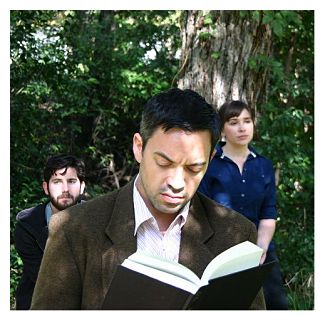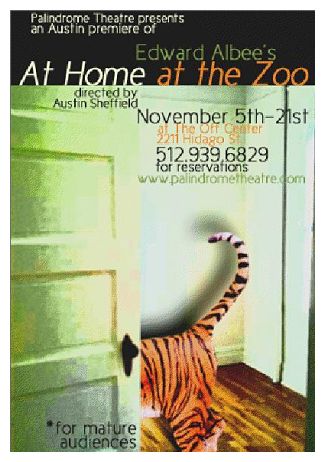Review: At Home at the Zoo by Palindrome Theatre (2010-2013)
by Michael Meigs
Edward Albee once commented, "If you can sum a play in one sentence, that's how long the play should be." That's a fine bon mot and a cutting challenge to all who try to work in the odd art form of the theatre review.
Albee has challenged and puzzled the public, the theatre community and academics since The Zoo Story, the second half of this theatre evening, first took the stage in Berlin 51 years ago. I have on my desk the Austin Public Library's copy of the Prentice-Hall collection of essays on Albee, published in 1975, where writers try to deal with The Zoo Story, Who's Afraid of Virginia Woolf and other pieces written in the opening decades of the playwright's career.
I remember vividly reading The Zoo Story, probably for a university class back in the late 1960's -- when it was new, so to speak, and path-breaking, a glimpse beyond the comfortable categories of American drama. It's interesting that a couple of the writers in the 1975 compendium -- which I've glanced at but not read attentively -- seek to interpret the piece through the lens of the Theatre of the Absurd. Martin Esslin, inventor of the term, in fact faults Albee for not pushing the situation to absurdity, for not taking the rant and ultimately the threats of a deranged New Yorker far enough.
But that was the fascination of the piece: that its poetic intensity of horror was completely plausible. Certainly to those us in the hinterlands, and probably even more so to New Yorkers, even in the comfortable late 1950's. Hasn't the poetry of threat and violence been played out over and over again in the past 50 years, distilled and dealt out by the media in doses that make The Zoo Story seem simple and sensible by comparison?
 The Zoo Story is a virtuoso piece for two actors who play Peter, a sedentary editor seated with a book on a bench in Central Park, and Jerry, the shabby man who intrudes into that quiet space with questions, conversation and an increasingly agitated account of his life and his desperations. We know from the first moment that this encounter between the comfortable and the dispossessed cannot turn out well, however amiable the exchanges, and the story ramps up to an ending of shocking violence. Jude Hickey is the editor and Nigel O'Hearn is the intruder. You couldn't cast this piece any better, at least, not here in Austin. Leave aside the B. Iden Payne nominations and awards that these guys have picked up recently. Their concentration and conviction, the subtly tightening tensions of demeanor and movement worked out with director Austin Sheffield, the rhythm, the emptiness of scene that Albee then furnishes with glowing hot images -- again, the new and youngish Palindrome company puts in front of us the intensity of stage experience.
The Zoo Story is a virtuoso piece for two actors who play Peter, a sedentary editor seated with a book on a bench in Central Park, and Jerry, the shabby man who intrudes into that quiet space with questions, conversation and an increasingly agitated account of his life and his desperations. We know from the first moment that this encounter between the comfortable and the dispossessed cannot turn out well, however amiable the exchanges, and the story ramps up to an ending of shocking violence. Jude Hickey is the editor and Nigel O'Hearn is the intruder. You couldn't cast this piece any better, at least, not here in Austin. Leave aside the B. Iden Payne nominations and awards that these guys have picked up recently. Their concentration and conviction, the subtly tightening tensions of demeanor and movement worked out with director Austin Sheffield, the rhythm, the emptiness of scene that Albee then furnishes with glowing hot images -- again, the new and youngish Palindrome company puts in front of us the intensity of stage experience.
In 2004 Edward Albee wrote a companion piece, a first act at home between that reticent matter-of-fact editor and his wife, Ann, played here by Robin Grace Thompson. In that imagining, written fifty years after the testosterone nightmare of The Zoo Story, I found the single sentence with which to summarize this new-old play. Peter sits on the couch, blue-penciling a thick manuscript on some recondite subject and Ann comes in, wearing an apron, from stage left. She looks at him. She says, "We should talk!"
We should talk.
This husband and wife, together for decades, are deep in their routines, their family life with two daughters and two cats and two parakeets, and Ann is unwittingly opening a conversation that will tear down their carefully constructed lives, eventually pulling forth from Peter a narrative of humiliation and violence. Just as half an hour later in stage time Jerry will relentlessly pull apart social convention, building an unwanted intimacy with Peter and pushing to an act of violence. In each case because the tacit boundaries protecting intimacy and privacy are breached.
Albee announced in 2009 that he will no longer authorize professional productions of The Zoo Story. He will require theatre companies to present these one-acts together as this amplified view, titled At Home at the Zoo. Educational and amateur companies will still be permitted to re-create the fatal duo of Peter and Jerry.
Albee's picture of married life in this piece is an almost solarized opposite of the wicked savageries of Who's Afraid of Virginia Wolf. Robin Grace Thompson is courteous with her husband, distracted by domesticity and completely unaware of his dangers and depths. But in some ways, it seems, she's just as dangerous to him as Martha is to George in the longer play -- now onstage at the Mary Moody Northen Theatre at St. Edward's University.
Palindrome will be staging a Monday night performance of At Home at the Zoo on November 15. That relatively unusual Monday staging will permit theatre artists from other Austin productions to attend, including cast members from Who's Afraid of Virginia Woolf. Afterward there will be a discussion between the actors, perhaps between the characters, from those two worlds of Edward Albee.
That's right. We should talk.
Or perhaps, from Albee, as an admonition for the characters: We shouldn't talk.
Review by Cate Blouke for the Statesman's Austin360 "Seeing Things" blog, November 8
Review by Elizabeth Cobbe for the Austin Chronicle, November 11
Review by webmaster at TheatreAustin, Yahoo webgroups, November 12
EXTRA
Click to view the program of At Home at the Zoo by Edward Albee presented by Palindrome Theatre (pt.1; pt. 2)
Hits as of 2015 03 01: 1967
At Home at the Zoo
by Edward Albee
Palindrome Theatre (2010-2013)
2211-A Hidalgo Street
near Robert Martinez and E. 7th Street, behind Joe's Bakery
Austin, TX, 78702
